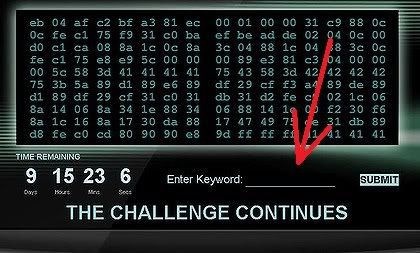// by petter wahlman, twitter: @badeip
// solution to part #1 of
http://www.canyoucrackit.co.uk/
//
// part2.h will be published along with solutions to the subsequent levels after 12 December 2011
#include <stdio.h>
#include <stdint.h>
#include <malloc.h>
#include <stdlib.h>
#include <errno.h>
#include <string.h>
#include <time.h>
#include <sys/types.h>
#include <sys/mman.h>
#include <sys/utsname.h>
#include "part2.h" // see information above
static char part1[] = {
0xeb, 0x04, 0xaf, 0xc2, 0xbf, 0xa3, 0x81, 0xec, 0x00, 0x01, 0x00, 0x00, 0x31, 0xc9, 0x88, 0x0c,
0x0c, 0xfe, 0xc1, 0x75, 0xf9, 0x31, 0xc0, 0xba, 0xef, 0xbe, 0xad, 0xde, 0x02, 0x04, 0x0c, 0x00,
0xd0, 0xc1, 0xca, 0x08, 0x8a, 0x1c, 0x0c, 0x8a, 0x3c, 0x04, 0x88, 0x1c, 0x04, 0x88, 0x3c, 0x0c,
0xfe, 0xc1, 0x75, 0xe8, 0xe9, 0x5c, 0x00, 0x00, 0x00, 0x89, 0xe3, 0x81, 0xc3, 0x04, 0x00, 0x00,
0x00, 0x5c, 0x58, 0x3d, 0x41, 0x41, 0x41, 0x41, 0x75, 0x43, 0x58, 0x3d, 0x42, 0x42, 0x42, 0x42,
0x75, 0x3b, 0x5a, 0x89, 0xd1, 0x89, 0xe6, 0x89, 0xdf, 0x29, 0xcf, 0xf3, 0xa4, 0x89, 0xde, 0x89,
0xd1, 0x89, 0xdf, 0x29, 0xcf, 0x31, 0xc0, 0x31, 0xdb, 0x31, 0xd2, 0xfe, 0xc0, 0x02, 0x1c, 0x06,
0x8a, 0x14, 0x06, 0x8a, 0x34, 0x1e, 0x88, 0x34, 0x06, 0x88, 0x14, 0x1e, 0x00, 0xf2, 0x30, 0xf6,
0x8a, 0x1c, 0x16, 0x8a, 0x17, 0x30, 0xda, 0x88, 0x17, 0x47, 0x49, 0x75, 0xde, 0x31, 0xdb, 0x89,
0xd8, 0xfe, 0xc0, 0xcd, 0x80, 0x90, 0x90, 0xe8, 0x9d, 0xff, 0xff, 0xff, 0x41, 0x41, 0x41, 0x41,
};
// code to dump the decrypted memory:
static const char dump_mem[] = {
0xba, 0x31, 0x00, 0x00, 0x00, // mov edx, 0x40
0x8d, 0x4f, 0xce, // lea ecx, [edi-0x32]
0x31, 0xdb, // xor ebx, ebx
0x43, // inc ebx (stdout)
0x31, 0xc0, // xor eax, eax
0xb0, 0x04, // add al, 0x4 - sys_write
0xcd, 0x80, // int 0x80
0x31, 0xdb, // xor ebx,ebx
0x43, // inc ebx
0x31, 0xd2, // xor edx,edx
0x42, // inc edx
0x68, 0x0a, 0x00,0x00, 0x00, // push 0xa
0x8d, 0x0c, 0x24, // lea ecx,[esp]
0xb8, 0x04, 0x00,0x00, 0x00, // mov eax, 0x4
0xcd, 0x80, // int 0x80 - sys_write
0x31, 0xdb, // xor ebx,ebx
0x31, 0xc0, // xor eax,eax
0x40, // inc eax
0xcd, 0x80, // int 0x80 - sys_exit
};
uint32_t patch_mem(char *ptr, size_t size)
{
uint32_t i;
for (i = 0; i < size; i++) {
if (*(uint16_t *)&ptr
== 0x80cd) {
*(uint16_t *)&ptr = 0x45eb;
return 0;
}
}
return 1;
}
uint32_t check_arch(void)
{
struct utsname kernel_info;
uname(&kernel_info);
return strcmp(kernel_info.machine, "i686") ? 1 : 0;
}
int main(int argc, char **argv)
{
void *mem;
if (check_arch()) {
printf("[-] this program must run on a 32-bit architecture\n");
return 1;
}
printf("
[*] allocating page aligned memory\n");
mem = memalign(4096, 4096);
if (!mem) {
printf("[-] error: %s\n", strerror(errno));
return 1;
}
memset(mem, 0, 4096);
printf("
[*] setting page permissions\n");
if (mprotect(mem, 4096, PROT_READ | PROT_WRITE | PROT_EXEC)) {
printf("[-] error: %s\n", strerror(errno));
return 1;
}
printf("
[*] copying payload\n");
memcpy(mem, part1, sizeof(part1));
memcpy(mem + sizeof(part1), part2, sizeof(part2));
memcpy(mem + sizeof(part1) + sizeof(part2), dump_mem, sizeof(dump_mem));
printf("
[*] adding dump_mem payload\n");
if (patch_mem(mem, sizeof(part1))) {
printf("[-] failed to patch memory\n");
return 0;
}
printf("
[*] executing payload..\n\n");
((int(*)(void))mem)();
return 0;
}




